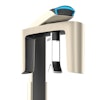
Editor's note: Edwin T. Parks' column, Talking Pictures, appears regularly on the DrBicuspid.com advice and opinion page, Second Opinion.
I attended the annual session of the American Academy of Oral and Maxillofacial Radiology earlier this month and saw some amazing images. The two that stuck in my mind were cross-sectional views of the mandible that showed an implant passing completely through the mandibular canal space!
Somehow I don't think 3D imaging was a part of the treatment planning process. How can 3D imaging be considered an extravagance compared to the morbidity associated with implant placement in the mandibular canal space, the maxillary sinus, or the adjacent tooth?
Let's look at conventional radiographic imaging for implant site assessment. While a periapical view provides excellent spatial resolution, the accuracy is only as good as the projection geometry. If the vertical angulation deviates from parallel to the long axis of the structure and the image receptor, the height of the ridge is distorted, as is the relationship of anatomic structures captured in the view. In a good periapical, you can determine the height of the ridge.
A panoramic view exhibits magnification that can be calculated by including an object of known dimensions (placed in the same plane as the ridge), measuring the dimensions in the image, and comparing to the dimensions of the object. As with periapical imaging, you can determine ridge height from the panoramic view. Unfortunately, neither of these images will tell you about the width of the ridge. You can determine the greatest dimensions of ridge width by taking an image 90° to the periapical image -- an occlusal view. But you still can't determine the topography of the ridge.
If you utilized a panoramic view and an occlusal view on this site, the measurements you would get would certainly differ from reality. If I'm having an implant placed, I want my surgeon to know the lay of the land before he picks up the drill!
The comments and observations expressed herein do not necessarily reflect the opinions of DrBicuspid.com, nor should they be construed as an endorsement or admonishment of any particular idea, vendor, or organization.
Copyright © 2008 DrBicuspid.com



















